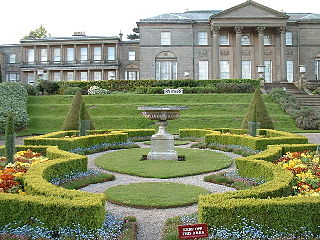
Castle Howard is an English country house in Henderskelfe, North Yorkshire, 15 miles (24 km) north of York. A private residence, it has been the home of the Carlisle branch of the Howard family for more than 300 years. Castle Howard has been used as a filming location in several films and television shows, including in Granada Television's 1981 television adaptation of Evelyn Waugh's Brideshead Revisited and in a 2008 film adaptation.

Temple Newsam, is a Tudor-Jacobean house in Leeds, West Yorkshire, England, with grounds landscaped by Capability Brown. The house is a Grade I listed building, one of nine Leeds Museums and Galleries sites and part of the research group, Yorkshire Country House Partnership.

Alrewas is a village and civil parish in the Lichfield District of Staffordshire, England.

Helmsley is a market town and civil parish in North Yorkshire, England. Historically part of the North Riding of Yorkshire, the town is located at the point where Ryedale leaves the moorland and joins the flat Vale of Pickering.

Tatton Park is a historic estate in Cheshire, England, north of the town of Knutsford. It contains a mansion, Tatton Hall; a medieval manor house, Tatton Old Hall; Tatton Park Gardens, a farm and a deer park of 2,000 acres (8.1 km2). It is a popular visitor attraction and hosts over a hundred events annually. The estate is owned by the National Trust and is managed under lease by Cheshire East Council. Since 1999, it has hosted North West England's annual Royal Horticultural Society flower show.

The Arboretum is a city park in Nottingham, England.

Duncombe Park is the seat of the Duncombe family who previously held the title Earls of Feversham. The title became extinct on the death of the 3rd Earl in 1963, since when the family have continued to hold the title Baron Feversham. The park is situated one mile south-west of Helmsley, North Yorkshire, England and stands in 300 acres (120 ha) of parkland. The estate has a commanding location above deeply incised meanders of the River Rye within the North York Moors National Park.

Ravensworth Castle is a ruined 14th-century castle in the village of Ravensworth, North Yorkshire, England. It has been designated a Grade I listed building by English Heritage.

Sandbeck Park is a Neo-Palladian country house in Maltby, South Yorkshire, England. The house dates to the 17th century and was extensively expanded and remodeled in the 18th and 19th centuries. The house is Grade I listed with Historic England and several outbuildings on the estate are also listed. The house has been the seat of the Earls of Scarbrough since the 18th century. The garden was designed by Lancelot Brown and is also Grade II* listed.

The Temple of the Four Winds is a historic building in the grounds of Castle Howard, in North Yorkshire, in England.

Henderskelfe is a civil parish in North Yorkshire, England. The parish does not contain any villages, though it is named after a previous settlement and castle which occupied the land on which Castle Howard is now built. Historically the area was a township in the ecclesiastical parish of Bulmer, however it has been its own civil parish since 1866.
Henderskelfe is a civil parish in the former Ryedale district of North Yorkshire, England. It contains 62 listed buildings that are recorded in the National Heritage List for England. Of these, 16 are listed at Grade I, the highest of the three grades, 16 are at Grade II*, the middle grade, and the others are at Grade II, the lowest grade. The parish does not contain any settlements, and its most important building is the country house, Castle Howard. This is listed, and all the other listed buildings in the parish are associated with the house, in its surroundings, gardens, grounds and estate.

The Walled Garden is a historic garden at Castle Howard, in North Yorkshire, in England. It contains several notable structures.

The Pyramid Gate, also known as the Pyramid Gatehouse, is a historic building at Castle Howard, in North Yorkshire, in England.

Ray Wood is a woodland area of the Castle Howard estate in North Yorkshire, in England. It contains several historic structures.

The Stables are a historic building at Castle Howard, in North Yorkshire, in England.

Pretty Wood is a woodland area of the Castle Howard estate in North Yorkshire, in England. It contains two historic structures.

The Mausoleum is a historic building on the Castle Howard estate in North Yorkshire, in England.

Castle Howard is a stately home in North Yorkshire, in England. It has extensive gardens, surrounded by a park. The grounds as a whole are grade I listed, while there are numerous listed structures within them.



















